Infant
Editor-In-Chief: C. Michael Gibson, M.S., M.D. [1]

In basic English usage, an infant is defined as a human child at the youngest stage of life, specifically before they can walk and generally before the age of one[1] (see also child and adolescent).
The term "infant" derives from the Latin word in-fans, meaning "unable to speak." There is no exact definition for infancy. "Infant" is also a legal term with the meaning of minor;[2] that is, any child under the age of legal adulthood.
A human infant less than a month old is a newborn infant or a neonate.[3] The term "newborn" includes premature infants, postmature infants and full term newborns.
Upon reaching the age of one or beginning to walk, infants are subsequently referred to as "toddlers" (generally 12-36 months). Daycares with an "infant room" often call all children in it "infants" even if they are older than a year and/or walking; they sometimes use the term "walking infant".
The newborn
Appearance
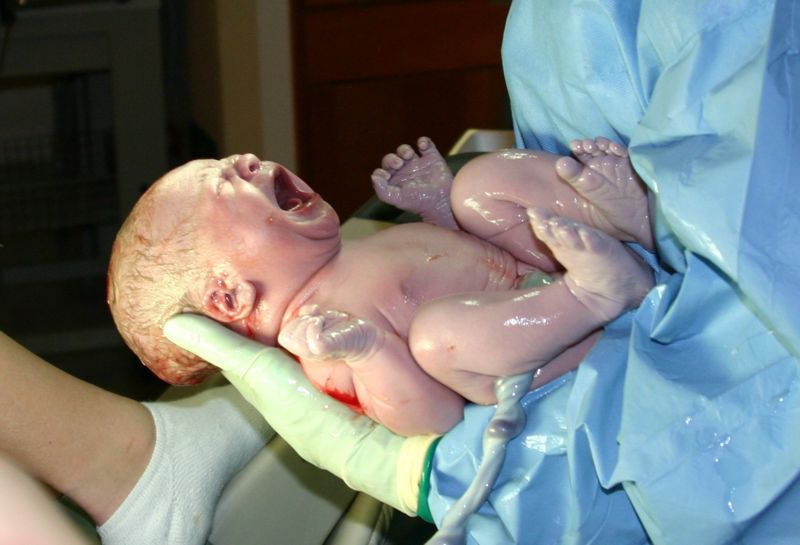
A newborn's shoulders and hips are narrow, the abdomen protrudes slightly, and the arms and legs are relatively short. The average birth weight of a full-term newborn is approximately 7 ½ lbs.(3.2 kg), but is typically in the range of 5.5–10 pounds (2.7–4.6 kg). The average total body length is 14–20 inches (35.6–50.8 cm), although premature newborns may be much smaller. The Apgar score is a measure of a newborn's transition from the uterus during the first minutes of life.
A newborn's head is very large in proportion to the rest of the body, and the cranium is enormous relative to his or her face. While the adult human skull is about 1/8 of the total body length, the newborn's is about 1/4. At birth, many regions of the newborn's skull have not yet been converted to bone, leaving "soft spots" known as fontanels. The two largest are the diamond-shaped anterior fontanel, located at the top front portion of the head, and the smaller triangular-shaped posterior fontanel, which lies at the back of the head. Later in the child's life, these bones will fuse together in a natural process. A protein called noggin is responsible for the delay in an infant's skull fusion.[4]
During labour and birth, the infant's skull changes shape to fit through the birth canal, sometimes causing the child to be born with a misshapen or elongated head. It will usually return to normal on its own within a few days or weeks. Special exercises sometimes advised by physicians may assist the process.
Some newborns have a fine, downy body hair called lanugo. It may be particularly noticeable on the back, shoulders, forehead, ears and face of premature infants. Lanugo disappears within a few weeks. Likewise, not all infants are born with lush heads of hair. Some may be nearly bald while others may have very fine, almost invisible hair. Some babies are even born with a full head of hair. Amongst fair-skinned parents, this fine hair may be blond, even if the parents are not. The scalp may also be temporarily bruised or swollen, especially in hairless newborns, and the area around the eyes may be puffy.
Immediately after birth, a newborn's skin is often grayish to dusky blue in color. As soon as the newborn begins to breathe, usually within a minute or two, the skin's color returns to its normal tone. Newborns are wet, covered in streaks of blood, and coated with a white substance known as vernix caseosa, which is hypothesised to act as an antibacterial barrier. The newborn may also have Mongolian spots, various other birthmarks, or peeling skin, particularly on the wrists, hands, ankles, and feet.
A newborn's genitals are enlarged and reddened, with male infants having an unusually large scrotum. The breasts may also be enlarged, even in male infants. This is caused by naturally-occurring maternal hormones and is a temporary condition. Females (and even males) may actually discharge milk from their nipples (sometimes called witch's milk), and/or a bloody or milky-like substance from the vagina. In either case, this is considered normal and will disappear in time.
The umbilical cord of a newborn is bluish-white in color. After birth, the umbilical cord is normally cut, leaving a 1–2 inch stub. The umbilical stub will dry out, shrivel, darken, and spontaneously fall off within about 3 weeks. Occasionally, hospitals may apply triple dye to the umbilical stub to prevent infection, which may temporarily color the stub and surrounding skin purple.
Newborns lose many of the above physical characteristics quickly. Thus prototypical older babies look very different. While older babies are considered "cute", newborns can be "unattractive" by the same criteria and first time parents may need to be educated in this regard.
The newborn's senses
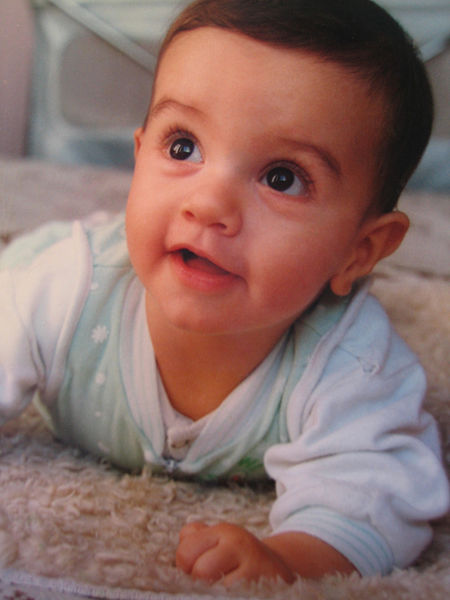
Newborns can feel all different sensations, but respond most enthusiastically to soft stroking, cuddling and caressing. Gentle rocking back and forth often calms a crying infant, as do massages and warm baths. Newborns may comfort themselves by sucking their thumb, or a pacifier. The need to suckle is instinctive (see suction in biology) and allows newborns to feed.
Newborn infants have unremarkable vision, being able to focus on objects only about 18 inches (45 cm) directly in front of their face. While this may not be much, it is all that is needed for the infant to look at the mother’s eyes or areola when breastfeeding. Generally, a newborn cries when wanting to feed. When a newborn is not sleeping, or feeding, or crying, he or she may spend a lot of time staring at random objects. Usually anything that is shiny, has sharp contrasting colors, or has complex patterns will catch an infant's eye. However, the newborn has a preference for looking at other human faces above all else. (see also: infant metaphysics and infant vision)
While still inside the mother, the infant could hear many internal noises, such as the mother's heartbeat, as well as many external noises including human voices, music and most other sounds. Therefore, although a newborn's ears may have some catarrh and fluid, he or she can hear sound from before birth. Newborns usually respond to a female voice over a male voice. This may explain why people will unknowingly raise the pitch of their voice when talking to newborns. The sound of other human voices, especially the mother's, can have a calming or soothing effect on the newborn. Conversely, loud or sudden noises will startle and scare a newborn.
Newborns can respond to different tastes, including sweet, sour, bitter, and salty substances, with a preference toward sweets.
A newborn has a developed sense of smell at birth, and within the first week of life can already distinguish the differences between the mother's own breast milk and the breast milk of another female.
Infant mortality
Infant mortality is the death of an infant in the first year of life. Infant mortality can be subdivided into neonatal death, referring to deaths in the first 27 days of life, and post-neonatal death, referring to deaths after 28 days of life. Major causes of infant mortality include dehydration, infection, congenital malformation, and SIDS.[5]
This epidemiological indicator is recognized as a very important measure of the level of health care in a country because it is directly linked with the health status of infants, children, and pregnant women as well as access to medical care, socioeconomic conditions, and public health practices.[6] [7]
Care and feeding
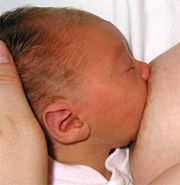
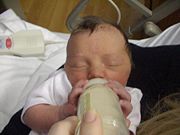
Infants cry as a form of basic instinctive communication. A crying infant may be trying to express a variety of feelings including hunger, discomfort, overstimulation, boredom or loneliness. Many caregivers employ the use of baby monitors or babycams which enable them to hear or see an infant's cries from another room.
Feeding is typically done by breastfeeding, which is the recommended method of feeding by all major infant health organizations including the American Academy of Pediatrics.[8] However, if breastfeeding is not possible or desired, bottle feeding may be done with expressed breast-milk or with infant formula. Infants have a sucking instinct allowing them to extract the milk from the nipples of the breasts or the nipple of the baby bottle, as well as an instinctive behavior known as rooting with which they seek out the nipple. Sometimes a wet nurse is hired to feed the infant, although this is rare, especially in developed countries.
As infants age, and their appetites grow, many parents choose from a variety of commercial, ready-made baby foods to supplement breast milk or formula for the child, while others adapt their usual meals for the dietary needs of their child. Infants are incontinent, therefore diapers are generally used in industrialized countries, while methods similar to elimination communication[9] are common in third world countries. Practitioners of these techniques assert that babies can control their bodily functions at the age of six months and that they are aware when they are urinating at an even earlier age. Babies can learn to signal to the parents when it is time to urinate or defecate by turning or making noises. Parents have to pay attention to the baby's actions so they can learn the signals.
Children need a relatively larger amount of sleep to function correctly (up to 18 hours for newborn babies, with a declining rate as the child ages), specially after feeding.

Babies cannot walk, although more mature infants may crawl or scoot; baby transport may be by perambulator (stroller or buggy), on the back or in front of an adult in a special carrier, cloth or cradle board, or simply by being carried in the arms. Most industrialized countries have laws requiring infants to be placed in special child safety seats when in motor vehicles.
As is the case with most other young children, infants are usually treated as special persons. Their social presence is different from that of adults, and they may be the focus of attention. Fees for transportation and entrance fees at locations such as amusement parks or museums are often waived. This special attention will wear out as the child grows older.
Common care issues for infants:
- Baby colic and/or gas.
- Childhood development.
- Hygiene:
- Day care.
- Diaper rash.
- Feeding: Breastfeeding or Infant formula (Baby bottle).
- Immunization.
- Paternal bond.
- Pacifier use.
- Sleep: bassinet and infant bed.
- Teething.
Bibliography
- Simkin, Penny (1992 (late 1991)). Pregnancy, Childbirth and the Newborn: The Complete Guide. Meadowbook Press. ISBN 0-88166-177-5. Unknown parameter
|coauthors=ignored (help); Unknown parameter|address=ignored (|location=suggested) (help); Check date values in:|year=(help)
References
- ↑ "Results for "infant"". dictionary.com. Unknown parameter
|accessldfwm;ljfdate=ignored (help) - ↑ ""Infant"". Merriam-Webster online dictionary. Merriam-Webster. Retrieved 2007-03-27.
- ↑ ""Neonate"". Merriam-Webster online dictionary. Merriam-Webster. Retrieved 2007-03-27.
- ↑ Warren SM (2003-04-10). "The BMP antagonist noggin regulates cranial suture fusion". Nature. 422 (6932): 625–9. PMID 12687003. Unknown parameter
|coauthors=ignored (help) - ↑ Garrett, Eilidh (2007). Infant Mortality: A Continuing Social Problem. Ashgate Pub Co. ISBN 0754645932.
- ↑ Hertz,, E (1994). "Social and environmental factors and life expectancy, infant mortality, and maternal mortality rates: results of a cross-national comparison". Soc Sci Med. 39 (1): 105–14. PMID 8066481. Unknown parameter
|month=ignored (help); Unknown parameter|coauthors=ignored (help);|access-date=requires|url=(help) - ↑ "The relationship between socioeconomic factors and maternal and infant health programs in 13 Argentine provinces". Rev Panam Salud Publica (in Spanish). 21 (4): 223–30. 2007. PMID 17612466. Unknown parameter
|month=ignored (help); Unknown parameter|coauthors=ignored (help);|access-date=requires|url=(help) - ↑ Gartner LM (February 2005). "Breastfeeding and the Use of Human Milk". Pediatrics: 496–506. doi:10.1542/peds.2004-2491. Unknown parameter
|coauthors=ignored (help); Unknown parameter|Issue=ignored (|issue=suggested) (help); Unknown parameter|Volume=ignored (|volume=suggested) (help) - ↑ "Elimination Communication". Yahoo! Groups. Retrieved 2007-03-27.
See also
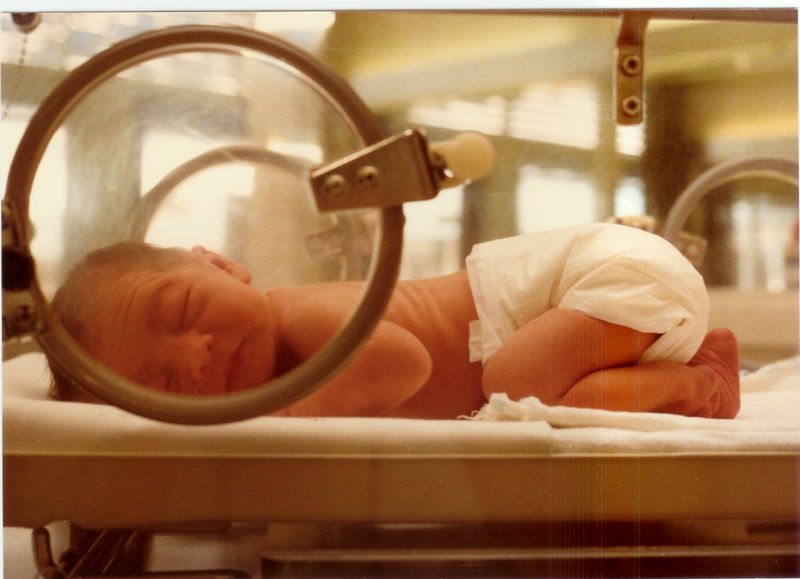
|
|
External links
- Discovery Health's Parenting Games
- Discovery Health's Infant & Toddler Center
- American Academy of Pediatrics
- CIA FactBook with infant mortality rates in different countries and other health indicators
- The World Health Report 2005 – Make Every Mother and Child
- Your Baby's Eyes.
Template:Start box Template:Succession box
ar:رضيع(حديث الولادة) cs:Kojenec da:Baby pdc:Bobbeli de:Säugling eo:Bebo id:Bayi it:Neonato he:ינקות nl:Baby no:Spedbarn simple:Baby sr:Новорођенче fi:Vauvaikä sv:Spädbarn yi:בעיבי zh-yue:蘇蝦仔